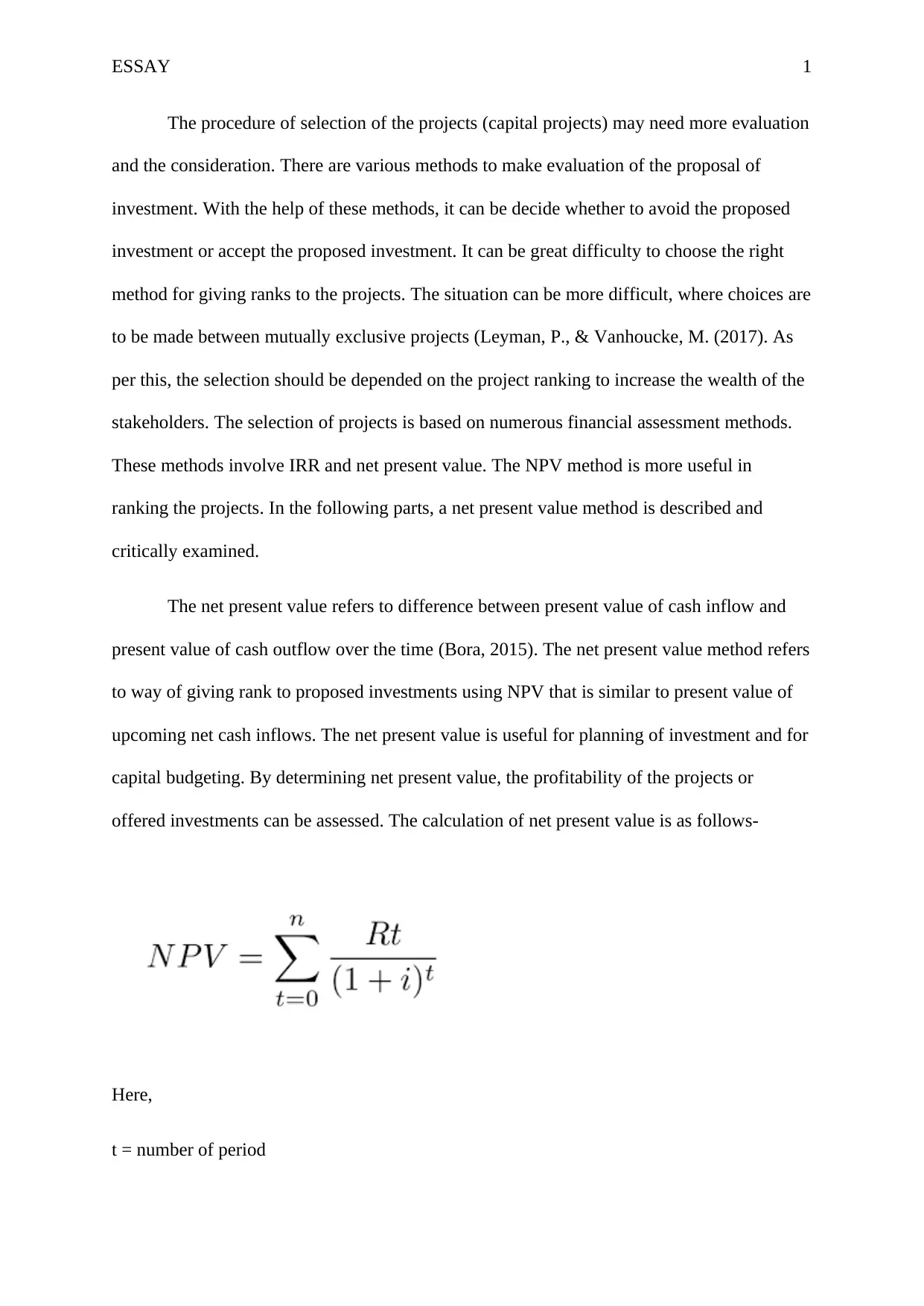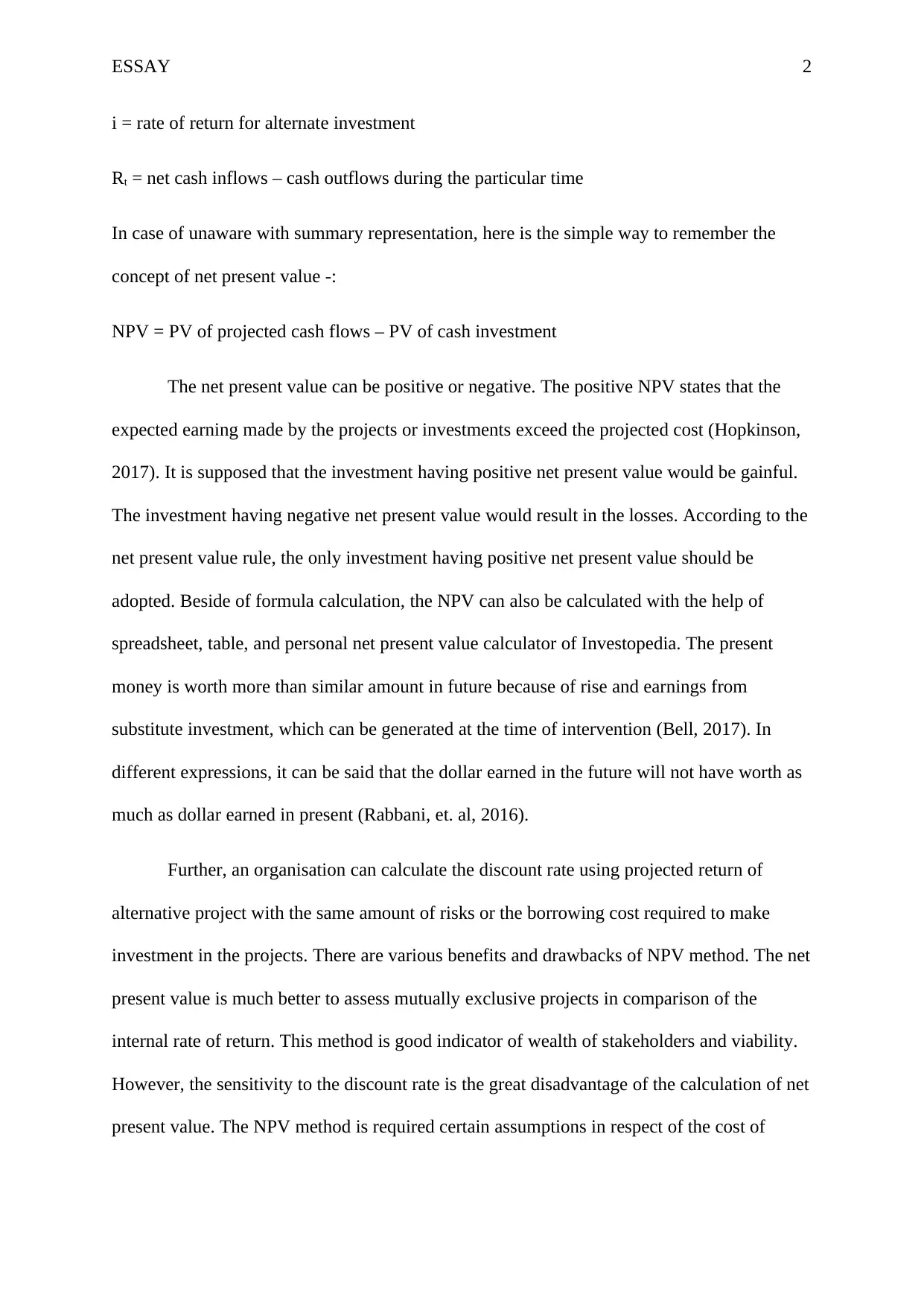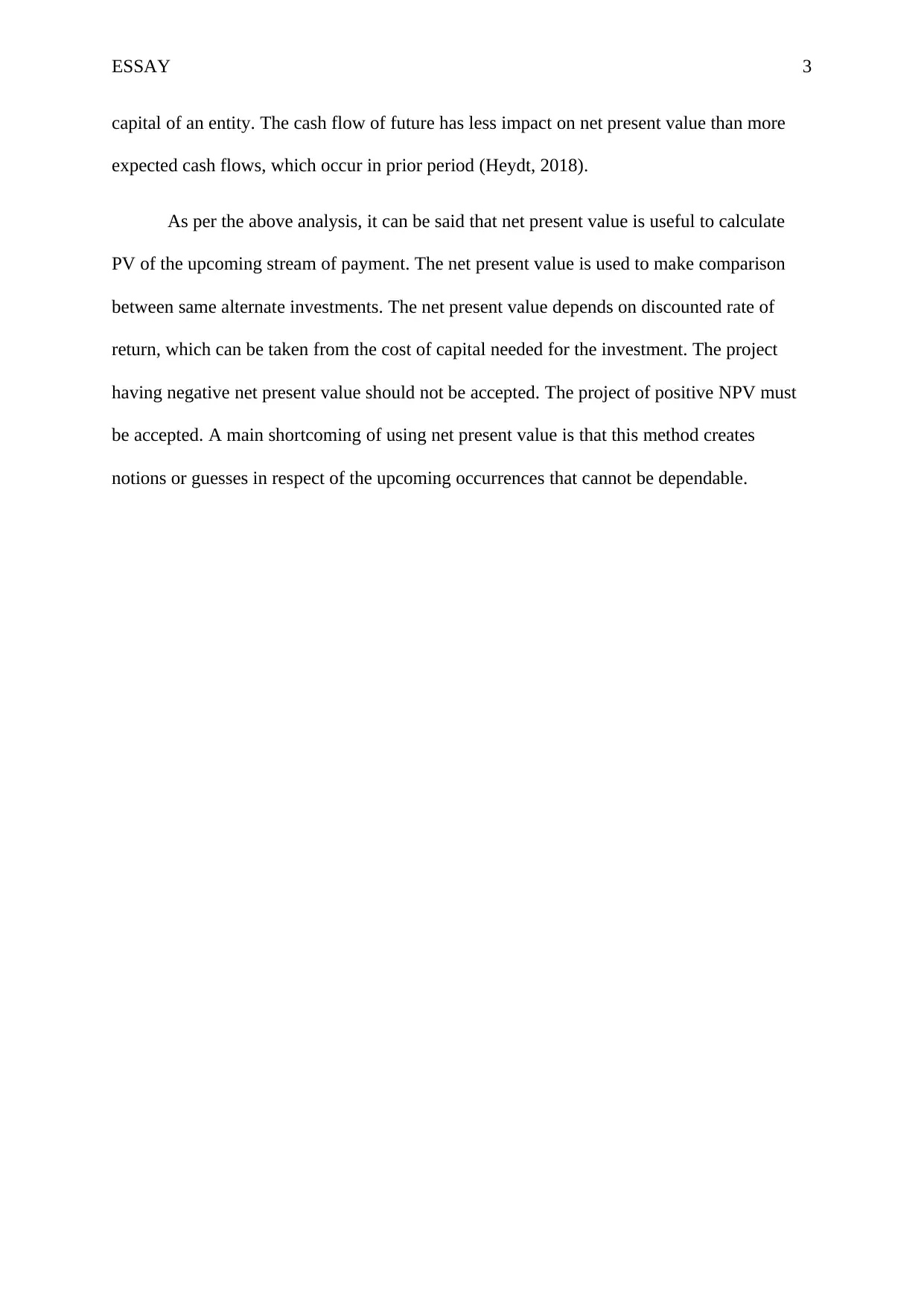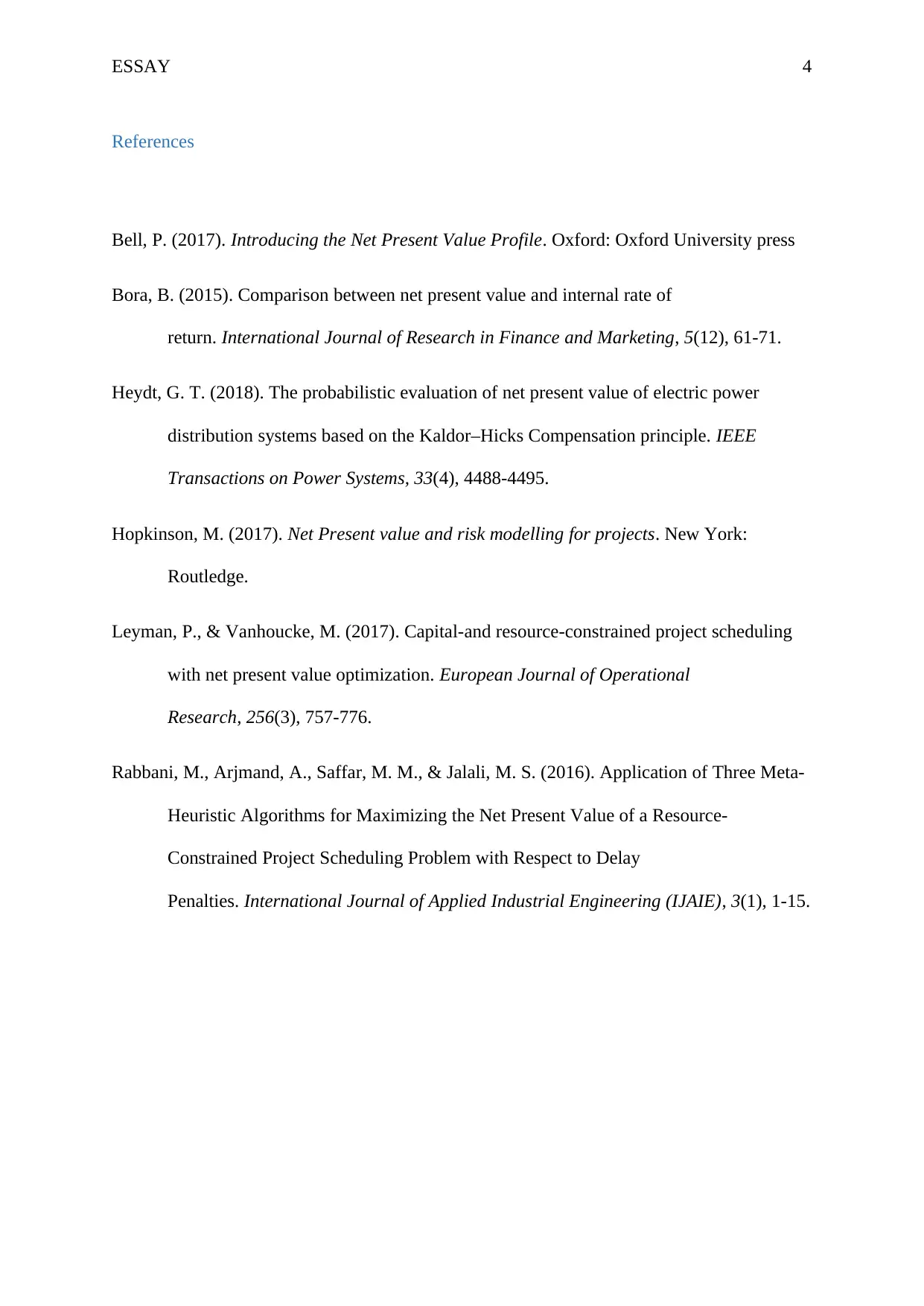Capital Project Evaluation: Using Net Present Value in Accounting
VerifiedAdded on 2023/04/26
|5
|1003
|387
Essay
AI Summary
This essay provides a detailed analysis of the net present value (NPV) method for evaluating and ranking capital projects in accounting. It defines NPV as the difference between the present value of cash inflows and outflows over time, highlighting its usefulness in investment planning and capital budgeting. The essay explains the NPV formula and its interpretation, noting that a positive NPV indicates a profitable investment while a negative NPV suggests potential losses. It also discusses the advantages and disadvantages of the NPV method, including its sensitivity to the discount rate and the inherent assumptions about future cash flows. The essay concludes that while NPV is a valuable tool for comparing alternative investments, its reliance on estimations requires careful consideration of potential uncertainties.

Running head: ESSAY 0
accounting
FEBRUARY 7, 2019
STUDENT DETAILS:
accounting
FEBRUARY 7, 2019
STUDENT DETAILS:
Paraphrase This Document
Need a fresh take? Get an instant paraphrase of this document with our AI Paraphraser

ESSAY 1
The procedure of selection of the projects (capital projects) may need more evaluation
and the consideration. There are various methods to make evaluation of the proposal of
investment. With the help of these methods, it can be decide whether to avoid the proposed
investment or accept the proposed investment. It can be great difficulty to choose the right
method for giving ranks to the projects. The situation can be more difficult, where choices are
to be made between mutually exclusive projects (Leyman, P., & Vanhoucke, M. (2017). As
per this, the selection should be depended on the project ranking to increase the wealth of the
stakeholders. The selection of projects is based on numerous financial assessment methods.
These methods involve IRR and net present value. The NPV method is more useful in
ranking the projects. In the following parts, a net present value method is described and
critically examined.
The net present value refers to difference between present value of cash inflow and
present value of cash outflow over the time (Bora, 2015). The net present value method refers
to way of giving rank to proposed investments using NPV that is similar to present value of
upcoming net cash inflows. The net present value is useful for planning of investment and for
capital budgeting. By determining net present value, the profitability of the projects or
offered investments can be assessed. The calculation of net present value is as follows-
Here,
t = number of period
The procedure of selection of the projects (capital projects) may need more evaluation
and the consideration. There are various methods to make evaluation of the proposal of
investment. With the help of these methods, it can be decide whether to avoid the proposed
investment or accept the proposed investment. It can be great difficulty to choose the right
method for giving ranks to the projects. The situation can be more difficult, where choices are
to be made between mutually exclusive projects (Leyman, P., & Vanhoucke, M. (2017). As
per this, the selection should be depended on the project ranking to increase the wealth of the
stakeholders. The selection of projects is based on numerous financial assessment methods.
These methods involve IRR and net present value. The NPV method is more useful in
ranking the projects. In the following parts, a net present value method is described and
critically examined.
The net present value refers to difference between present value of cash inflow and
present value of cash outflow over the time (Bora, 2015). The net present value method refers
to way of giving rank to proposed investments using NPV that is similar to present value of
upcoming net cash inflows. The net present value is useful for planning of investment and for
capital budgeting. By determining net present value, the profitability of the projects or
offered investments can be assessed. The calculation of net present value is as follows-
Here,
t = number of period

ESSAY 2
i = rate of return for alternate investment
Rt = net cash inflows – cash outflows during the particular time
In case of unaware with summary representation, here is the simple way to remember the
concept of net present value -:
NPV = PV of projected cash flows – PV of cash investment
The net present value can be positive or negative. The positive NPV states that the
expected earning made by the projects or investments exceed the projected cost (Hopkinson,
2017). It is supposed that the investment having positive net present value would be gainful.
The investment having negative net present value would result in the losses. According to the
net present value rule, the only investment having positive net present value should be
adopted. Beside of formula calculation, the NPV can also be calculated with the help of
spreadsheet, table, and personal net present value calculator of Investopedia. The present
money is worth more than similar amount in future because of rise and earnings from
substitute investment, which can be generated at the time of intervention (Bell, 2017). In
different expressions, it can be said that the dollar earned in the future will not have worth as
much as dollar earned in present (Rabbani, et. al, 2016).
Further, an organisation can calculate the discount rate using projected return of
alternative project with the same amount of risks or the borrowing cost required to make
investment in the projects. There are various benefits and drawbacks of NPV method. The net
present value is much better to assess mutually exclusive projects in comparison of the
internal rate of return. This method is good indicator of wealth of stakeholders and viability.
However, the sensitivity to the discount rate is the great disadvantage of the calculation of net
present value. The NPV method is required certain assumptions in respect of the cost of
i = rate of return for alternate investment
Rt = net cash inflows – cash outflows during the particular time
In case of unaware with summary representation, here is the simple way to remember the
concept of net present value -:
NPV = PV of projected cash flows – PV of cash investment
The net present value can be positive or negative. The positive NPV states that the
expected earning made by the projects or investments exceed the projected cost (Hopkinson,
2017). It is supposed that the investment having positive net present value would be gainful.
The investment having negative net present value would result in the losses. According to the
net present value rule, the only investment having positive net present value should be
adopted. Beside of formula calculation, the NPV can also be calculated with the help of
spreadsheet, table, and personal net present value calculator of Investopedia. The present
money is worth more than similar amount in future because of rise and earnings from
substitute investment, which can be generated at the time of intervention (Bell, 2017). In
different expressions, it can be said that the dollar earned in the future will not have worth as
much as dollar earned in present (Rabbani, et. al, 2016).
Further, an organisation can calculate the discount rate using projected return of
alternative project with the same amount of risks or the borrowing cost required to make
investment in the projects. There are various benefits and drawbacks of NPV method. The net
present value is much better to assess mutually exclusive projects in comparison of the
internal rate of return. This method is good indicator of wealth of stakeholders and viability.
However, the sensitivity to the discount rate is the great disadvantage of the calculation of net
present value. The NPV method is required certain assumptions in respect of the cost of
⊘ This is a preview!⊘
Do you want full access?
Subscribe today to unlock all pages.

Trusted by 1+ million students worldwide

ESSAY 3
capital of an entity. The cash flow of future has less impact on net present value than more
expected cash flows, which occur in prior period (Heydt, 2018).
As per the above analysis, it can be said that net present value is useful to calculate
PV of the upcoming stream of payment. The net present value is used to make comparison
between same alternate investments. The net present value depends on discounted rate of
return, which can be taken from the cost of capital needed for the investment. The project
having negative net present value should not be accepted. The project of positive NPV must
be accepted. A main shortcoming of using net present value is that this method creates
notions or guesses in respect of the upcoming occurrences that cannot be dependable.
capital of an entity. The cash flow of future has less impact on net present value than more
expected cash flows, which occur in prior period (Heydt, 2018).
As per the above analysis, it can be said that net present value is useful to calculate
PV of the upcoming stream of payment. The net present value is used to make comparison
between same alternate investments. The net present value depends on discounted rate of
return, which can be taken from the cost of capital needed for the investment. The project
having negative net present value should not be accepted. The project of positive NPV must
be accepted. A main shortcoming of using net present value is that this method creates
notions or guesses in respect of the upcoming occurrences that cannot be dependable.
Paraphrase This Document
Need a fresh take? Get an instant paraphrase of this document with our AI Paraphraser

ESSAY 4
References
Bell, P. (2017). Introducing the Net Present Value Profile. Oxford: Oxford University press
Bora, B. (2015). Comparison between net present value and internal rate of
return. International Journal of Research in Finance and Marketing, 5(12), 61-71.
Heydt, G. T. (2018). The probabilistic evaluation of net present value of electric power
distribution systems based on the Kaldor–Hicks Compensation principle. IEEE
Transactions on Power Systems, 33(4), 4488-4495.
Hopkinson, M. (2017). Net Present value and risk modelling for projects. New York:
Routledge.
Leyman, P., & Vanhoucke, M. (2017). Capital-and resource-constrained project scheduling
with net present value optimization. European Journal of Operational
Research, 256(3), 757-776.
Rabbani, M., Arjmand, A., Saffar, M. M., & Jalali, M. S. (2016). Application of Three Meta-
Heuristic Algorithms for Maximizing the Net Present Value of a Resource-
Constrained Project Scheduling Problem with Respect to Delay
Penalties. International Journal of Applied Industrial Engineering (IJAIE), 3(1), 1-15.
References
Bell, P. (2017). Introducing the Net Present Value Profile. Oxford: Oxford University press
Bora, B. (2015). Comparison between net present value and internal rate of
return. International Journal of Research in Finance and Marketing, 5(12), 61-71.
Heydt, G. T. (2018). The probabilistic evaluation of net present value of electric power
distribution systems based on the Kaldor–Hicks Compensation principle. IEEE
Transactions on Power Systems, 33(4), 4488-4495.
Hopkinson, M. (2017). Net Present value and risk modelling for projects. New York:
Routledge.
Leyman, P., & Vanhoucke, M. (2017). Capital-and resource-constrained project scheduling
with net present value optimization. European Journal of Operational
Research, 256(3), 757-776.
Rabbani, M., Arjmand, A., Saffar, M. M., & Jalali, M. S. (2016). Application of Three Meta-
Heuristic Algorithms for Maximizing the Net Present Value of a Resource-
Constrained Project Scheduling Problem with Respect to Delay
Penalties. International Journal of Applied Industrial Engineering (IJAIE), 3(1), 1-15.
1 out of 5
Related Documents
Your All-in-One AI-Powered Toolkit for Academic Success.
+13062052269
info@desklib.com
Available 24*7 on WhatsApp / Email
![[object Object]](/_next/static/media/star-bottom.7253800d.svg)
Unlock your academic potential
Copyright © 2020–2025 A2Z Services. All Rights Reserved. Developed and managed by ZUCOL.




